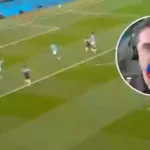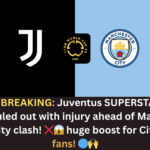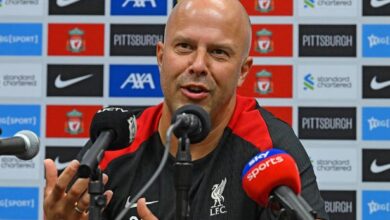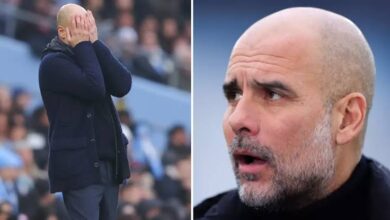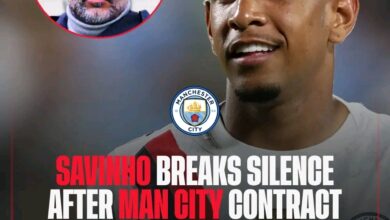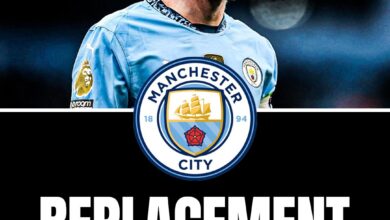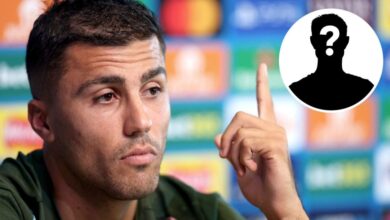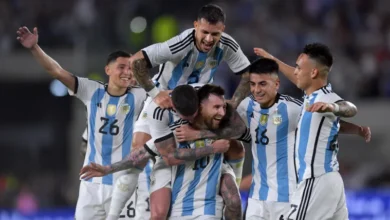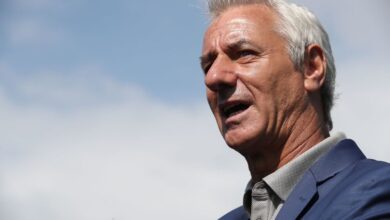Champions League Showdown: Manchester City’s Injury Crisis Ahead of Crucial Aston Villa Clash
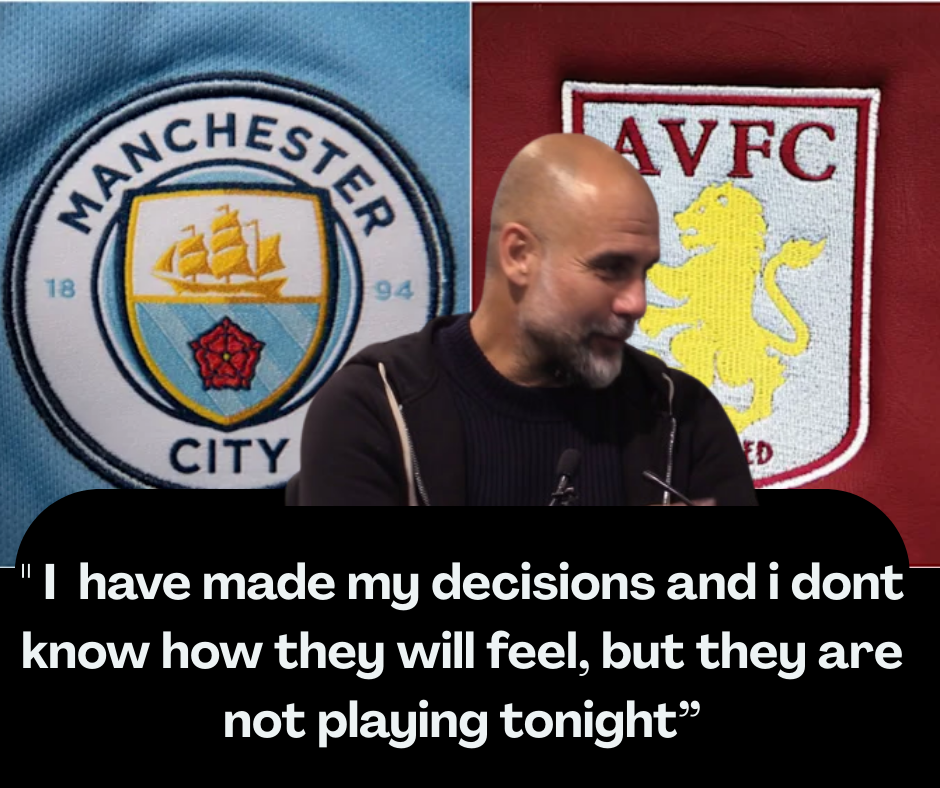
As Manchester City prepares for what could be a season-defining fixture against Aston Villa, Pep Guardiola finds himself navigating through a significant injury crisis that threatens to derail the club’s Champions League qualification hopes. With five key players potentially sidelined for this critical encounter, City’s depth and resilience will be tested against Unai Emery’s in-form Villa side in what many are calling a Champions League six-pointer.
Manchester City’s 2024-25 campaign has taken an unexpected turn. After years of Premier League dominance and automatic Champions League qualification, the Citizens now find themselves in an unfamiliar position—battling for a top-five spot that would secure their place in Europe’s elite competition next season. Their recent 2-0 victory over Everton at Goodison Park was a vital result that moved them into the coveted Champions League positions, but the injury situation looming over the squad casts a shadow on their prospects.
This evening’s clash against Aston Villa at the Etihad Stadium represents more than just another Premier League fixture. It’s a direct confrontation with a fellow Champions League aspirant, making it a true six-pointer in every sense. A win would consolidate City’s position in the top five and potentially create crucial breathing space in the qualification race, while a defeat would not only surrender points but hand a direct competitor a significant advantage in the final stretch of the season.
For a club of City’s stature and ambition, missing out on Champions League football would be considered catastrophic—both from a financial perspective and in terms of the ability to attract and retain elite talent. The pressure is mounting on Guardiola’s squad, a situation made all the more precarious by the absence of several key figures.The most significant absence for Manchester City continues to be Spanish international Rodri, whose season has been derailed by a severe knee injury suffered in September. The midfielder, who has established himself as one of the world’s premier defensive midfielders under Guardiola’s tutelage, required surgery and has been engaged in a lengthy rehabilitation process ever since.
Rodri’s importance to City’s tactical setup cannot be overstated. Acting as the fulcrum between defense and attack, his ability to break up opposition plays, retain possession under pressure, and initiate attacks with progressive passing has been sorely missed. The statistical drop-off in City’s control metrics since his injury tells its own story—fewer successful passes in the opposition half, reduced possession percentages, and an increased vulnerability to counter-attacks.
Various midfield combinations have been deployed in an attempt to compensate for Rodri’s absence, but none have provided the same level of balance and control. His experience in high-stakes fixtures would have been particularly valuable against an Aston Villa side known for their rapid transitions and midfield dynamism.Perhaps the most discussed absence is that of prolific striker Erling Haaland, who has been out of action since suffering an ankle injury during City’s FA Cup quarter-final victory over Bournemouth last month. The Norwegian goal machine had been enjoying another remarkable scoring season before his setback, and his absence has forced Guardiola to reimagine his attacking approach.
While City’s medical team has indicated that Haaland should return before the end of the campaign, his unavailability for the Villa clash represents a massive blow. Against a well-organized defensive unit like Villa’s, Haaland’s physical presence, clinical finishing, and ability to occupy multiple defenders would have been invaluable assets.
In Haaland’s absence, Guardiola has experimented with both Julian Alvarez as a traditional number nine and a more fluid false nine system incorporating Phil Foden in a central role. While both approaches have yielded some success, neither provides the same devastating focal point that Haaland offers when fit. The Norwegian’s mere presence creates space for City’s creative midfielders by drawing defensive attention, an advantage they’ll be without this evening
England international John Stones remains on the sidelines with a thigh injury sustained during the Champions League encounter with Real Madrid. His absence further depletes City’s defensive options at a time when stability at the back is paramount.
Stones’ evolution under Guardiola has been remarkable, transforming from a ball-playing defender into a versatile tactical chess piece capable of stepping into midfield or providing defensive solidity as required. His partnership with Ruben Dias had become one of the most formidable in European football, combining technical assurance with physical robustness.
While City hope to have Stones available again in the coming weeks, his absence against Villa means Guardiola must continue with makeshift defensive arrangements. This could involve Manuel Akanji partnering Dias, or potentially a more experimental setup involving Nathan Aké—though the Dutchman has injury concerns of his own.Speaking of Aké, the versatile Dutch defender represents another significant absentee from Guardiola’s squad. Following a foot injury during the FA Cup victory over Plymouth Argyle, Aké underwent surgery last month and remains in the rehabilitation phase of his recovery.
Though often overshadowed by some of City’s more celebrated defenders, Aké’s importance to the squad cannot be underestimated. His positional versatility—comfortable at center-back, left-back, or even in a defensive midfield role—provides Guardiola with valuable tactical flexibility. His absence, combined with that of Stones, severely restricts the manager’s defensive options.
City’s medical team is optimistic about Aké’s return before the season concludes, but the Villa fixture comes too soon in his recovery timeline. His absence is particularly concerning given Villa’s potent attacking options, including the in-form Ollie Watkins and the creative threat posed by Emiliano Buendia.Completing City’s injury concerns is first-choice goalkeeper Ederson, who missed the weekend win over Everton after being substituted during the 5-2 victory against Crystal Palace earlier this month. The Brazilian’s status remains uncertain for the Villa clash, creating a significant question mark over such a crucial position.
Ederson’s value to Manchester City extends far beyond his shot-stopping abilities. His exceptional distribution and comfort with the ball at his feet are fundamental components of Guardiola’s playing philosophy, enabling City to build attacks from the very back and maintain their positional structure under pressure.
In Ederson’s absence, Stefan Ortega stepped in against Everton and performed admirably. However, the German doesn’t offer the same level of passing range or command of his area as the Brazilian number one. Against a Villa side likely to press aggressively and target potential weaknesses in City’s build-up play, Ederson’s potential absence represents a significant concern.
In stark contrast to Manchester City’s injury worries, Aston Villa manager Unai Emery is expected to have a full squad at his disposal for this evening’s encounter. This represents a significant advantage in a fixture of such magnitude, allowing the Spanish tactician to select his optimal lineup without compromise.
Villa’s strength in depth was highlighted by Emery’s team selection dilemma for their recent victory over Newcastle United, where he was forced to leave quality players like Pau Torres, Lamare Bogarde, and Leon Bailey out of the matchday squad entirely due to the Premier League’s 20-player limit for team sheets. This embarrassment of riches provides Villa with fresh legs and tactical options as they visit the Etihad Stadium.
The full availability of Villa’s squad means they can maintain the high-intensity pressing game that has become their hallmark under Emery, potentially exploiting any fatigue in a depleted City side. With players like Watkins, Buendia, and Youri Tielemans in excellent form, Villa represent formidable opposition even for a fully-fit City team—let alone one ravaged by injuries to key personnel.
Despite the mounting injury concerns, Pep Guardiola has maintained his characteristically philosophical approach to the situation. Speaking ahead of the Crystal Palace match, the Catalan manager framed the injury crisis as an opportunity rather than a disaster: “[Injuries] happened all season, we adapt,” he said. “You can see it as a problem or a challenge, the position is a disaster or it could be worse.”
This perspective reflects Guardiola’s pragmatic side, focusing on what remains within his control rather than lamenting unavailable options. “I’m happy with the way we handled the situation and where we are,” he continued, striking a surprisingly optimistic tone given the circumstances.
However, even Guardiola has acknowledged the significance of the challenge facing his team: “The challenge is to qualify in the Champions League next season, the home games, difficult ones we have and tomorrow we have a team in incredible top form in the last month or two months.”
This realistic assessment demonstrates Guardiola’s understanding of the precarious position City find themselves in. Unlike previous seasons where they’ve approached the final stretch with comfortable margins in the title race, this campaign requires a scrappy, determined approach to secure Champions League qualification—a minimum requirement for a club of City’s stature.
Despite the injury crisis, Guardiola still has significant talent at his disposal. The question becomes how best to deploy the available resources against a well-drilled Villa outfit. Several potential approaches could be considered: Without Rodri’s controlling presence and Haaland’s penalty-box threat, City might opt to flood the midfield with technical players capable of maintaining possession and creating numerical overloads. A potential lineup could see Kevin De Bruyne deployed in a deeper role alongside Mateo Kovačić, with Bernardo Silva, Phil Foden, and Jeremy Doku forming a fluid attacking midfield trio behind Julian Alvarez.
This approach would prioritize ball retention and pressing, aiming to stifle Villa’s transitions before they can develop. The risk, however, is a lack of cutting edge in the final third without Haaland’s presence.Alternatively, Guardiola might revert to the false nine system that served City well before Haaland’s arrival. This would likely see Phil Foden deployed as the central attacker, dropping deep to create space for midfield runners like Bernardo Silva and Kevin De Bruyne to exploit.
This fluid system could potentially confuse Villa’s defensive structure, which is more accustomed to dealing with traditional center forwards. However, it requires impeccable timing and movement from all involved, particularly challenging with a team disrupted by injuries.Given the depleted defensive resources and Villa’s counter-attacking threat, Guardiola might prioritize defensive stability over offensive flair. This could involve a double pivot of Mateo Kovačić and Rico Lewis to shield the backline, with more conservative positioning from the full-backs to prevent exposure on transitions.
While this approach might sacrifice some of City’s attacking potential, it could provide the structural security needed against a dangerous Villa forward line. The emphasis would shift to moments of individual quality from players like De Bruyne and Foden to unlock a disciplined defensive setup.
Beyond tactical considerations, the injury crisis presents a significant psychological challenge for Manchester City. After years of dominance in which they’ve often been able to overwhelm opponents through superior quality across the pitch, they now find themselves in the unfamiliar position of being potentially vulnerable.
How the available players respond to this challenge could define not just the outcome of the Villa fixture but the remainder of their season. Will they embrace Guardiola’s framing of the situation as a “challenge” rather than a “problem”? Can they summon the resilience and adaptive capacity that has characterized the most successful periods of the Guardiola era?
The leadership of figures like Kevin De Bruyne becomes particularly crucial in such moments. As one of the few world-class performers still available for selection, the Belgian playmaker’s ability to inspire those around him and elevate the collective performance level could prove decisive.
Manchester City’s injury crisis and unexpected battle for Champions League qualification must be viewed within the broader context of what has become a transitional season for the club. After the unprecedented treble success of the previous campaign, maintaining such extraordinary standards was always going to be challenging—particularly with the departure of key figures like Ilkay Gündogan and the aging of certain squad members.
The current situation represents perhaps the most significant test of Guardiola’s tenure at the Etihad Stadium. Having recently signed a contract extension that commits him to the club until 2027, the Catalan must now navigate this difficult period while simultaneously planning for the squad renewal that will define the next phase of his City project.
How City emerge from this challenging period will reveal much about the club’s resilience and Guardiola’s capacity to reinvent his team. A positive result against Villa despite the injury obstacles would represent a significant psychological boost and potentially a turning point in what has been an uncharacteristically difficult season.
While the immediate focus remains on securing three points against Aston Villa, the implications of tonight’s result extend far beyond the Premier League table. Champions League qualification isn’t merely about prestige—it’s fundamentally linked to the club’s financial model and transfer strategy.
The substantial revenue from Champions League participation is built into City’s budgetary planning, with potential losses running into tens of millions of pounds should they fail to qualify. This financial hit would inevitably impact their ability to compete for elite talent in the transfer market, potentially triggering a negative spiral that could take seasons to reverse.
Moreover, the allure of Champions League football is crucial for player recruitment and retention. As speculation continues to swirl around the futures of key players like Kevin De Bruyne, securing qualification becomes essential to convince such talents that the Etihad remains the optimal environment for their ambitions.
Aston Villa arrive at the Etihad with their own European ambitions, having enjoyed a remarkable renaissance under Unai Emery’s stewardship. The Spanish tactician has transformed Villa from relegation candidates to genuine Champions League contenders through tactical sophistication and astute recruitment.
Villa’s approach under Emery is characterized by disciplined defensive organization combined with rapid, vertical transitions. Their counter-attacking threat is particularly concerning for a City team missing key defensive personnel, with the pace and directness of players like Leon Bailey and Moussa Diaby potentially exploiting any structural vulnerabilities.
Emery’s extensive European experience—including four Europa League triumphs—provides him with the tactical acumen to approach this fixture strategically. Having already overseen a victory against Manchester United at Old Trafford this season, he’ll be confident in his team’s ability to secure another significant away result at the Etihad.
As Manchester City approaches this critical juncture in their season, the injury crisis arrives at the worst possible moment. Having clawed their way back into Champions League contention after a difficult period, they now face their most challenging fixture with severely depleted resources.
However, City’s current predicament also presents an opportunity for redemption. A victory against Villa despite the injury obstacles would represent not just three points but a powerful statement about the club’s resilience and depth. It would reinvigorate their Champions League qualification push and potentially provide the emotional catalyst needed for a strong finish to the season.
Conversely, a defeat would compound the difficulty of their situation, not just mathematically but psychologically. With matches against other European contenders still to come, City can ill afford to surrender points to direct rivals, particularly on home turf.
As Manchester City and Aston Villa prepare to face off at the Etihad Stadium, the fixture represents a potentially defining moment in both clubs’ seasons. For City, it’s an opportunity to demonstrate that they can overcome significant adversity through tactical flexibility and collective spirit. For Villa, it offers the chance to strike a decisive blow in the Champions League qualification race against a wounded opponent.
With five key players potentially missing, Guardiola faces one of the most significant challenges of his illustrious managerial career. His response—both in terms of tactical approach and psychological management—will reveal much about his adaptability and resilience as a coach.
The outcome of this evening’s encounter may well be remembered as the pivotal moment in Manchester City’s quest for Champions League qualification. In a season characterized by unprecedented challenges, their response to this injury crisis could define not just their immediate future but the longer-term trajectory of Guardiola’s project at the Etihad Stadium.
As the teams take to the field, the question remains: will City’s injury-hit squad find the resources to overcome a full-strength Villa, or will Emery’s men capitalize on their advantage to strike a potentially decisive blow in the race for Champions League football? The answer will begin to emerge at kick-off—and could resonate throughout the remainder of the Premier League season.
